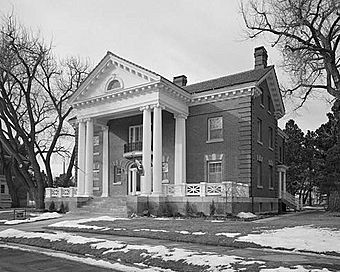Fort D. A. Russell (Wyoming) facts for kids
|
Fort D. A. Russell
|
|

Commanding Officer's Quarters, Fort David A. Russell
|
|
| Lua error in Module:Location_map at line 420: attempt to index field 'wikibase' (a nil value). | |
| Location | Laramie County, adjacent to west side of Cheyenne, Wyoming |
|---|---|
| Area | 630 acres (250 ha) |
| Built | 1867 |
| NRHP reference No. | 69000191 |
Quick facts for kids Significant dates |
|
| Added to NRHP | October 1, 1969 |
| Designated NHLD | May 15, 1975 |
Fort D. A. Russell was an important military base in Cheyenne, Wyoming. It was also known by other names like Fort Francis E. Warren and Francis E. Warren Air Force Base. The United States Army first built this fort in 1867. Its main job was to protect workers building the Union Pacific Railroad.
The fort was named after David Allen Russell. He was a general in the American Civil War who died in battle. Later, in 1930, the fort's name changed to Fort Francis E. Warren. Then, in 1949, it became the Francis E. Warren Air Force Base. Many famous military leaders lived or worked here over the years. These included John J. Pershing, Billy Mitchell, and Carl Spaatz.
A special part of the base was named a National Historic Landmark District in 1975. This was because it showed how the base changed over time. It went from a frontier cavalry post to a modern Air Force base.
Contents
Building the Fort
Units from the 30th Infantry started building the fort in August 1867. Colonel John Dunlap Stevenson led these soldiers. Soon after, in September, the first cavalry soldiers arrived. They were from Company H of the 2nd Cavalry.
In 1884, Fort D. A. Russell became a permanent military base. It was home to some famous Black regiments. These included the 9th and 10th Cavalry. The 24th Infantry also served there. These brave soldiers were known as the Buffalo Soldiers. They were stationed at the fort for many years in the late 1800s.
Growing and Changing
By the early 1900s, Fort D. A. Russell was one of the biggest cavalry bases in the United States. It grew even larger with more buildings and land.
In 1919, an airfield was built at the fort. Soon, over 100 military airplanes were based there. This showed a big change from horses to planes. The last cavalry units left the base in 1927. In 1930, the base was renamed Fort Francis E. Warren. This new name honored Francis E. Warren. He was a Medal of Honor winner and a former Governor of Wyoming.
World War II and the Cold War
During World War II, Fort Francis E. Warren became a training center. It helped train soldiers for the United States Army Quartermaster Corps. These soldiers were in charge of supplies and logistics. The base also had a prisoner of war camp during this time.
In 1949, the base became the Francis E. Warren Air Force Base. In 1958, it joined the Strategic Air Command. This was a very important part of the Air Force. In 1963, the base became the main place for the 90th Strategic Missile Wing. This wing controlled over 200 ICBMs. These were powerful missiles used during the Cold War.
Warren Air Force Base was the only missile wing to have Peacekeeper missiles. These missiles were taken out of service in October 2005. On October 1, 1993, the Twentieth Air Force moved its headquarters to Warren. This group controls all of America's ICBM wings.
The fort was officially named a National Historic Landmark on May 15, 1975. It was still known as Francis E. Warren Air Force Base at that time.
Preserving History
Many of the old buildings at the historic district have been kept in good condition. Some buildings were updated to meet special historical standards. The Air Force has worked to restore parts of these historic structures.
Images for kids

